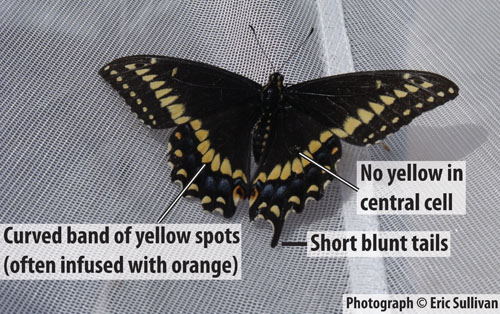Short-tailed Swallowtail (Papilio brevicauda)
Description: This is the only black swallowtail in the Maritimes besides Black Swallowtail. Short-tailed Swallowtail is distinguished by its shorter tail and shorter, more rounded forewing. See description of Black Swallowtail for more distinguishing characters. Wingspan: 57 to 73 mm.
Maritime Distribution: Coastal areas of northern and northeastern New Brunswick and northern Cape Breton Island. Not recorded on mainland Nova Scotia or Prince Edward Island. For Atlas results click here.
Provincial Ranks: NB: S3. NS: S1. PEI: -.
Flight Period: Late May to early July, partial second brood, August to early September.
Host Plant: Various members of the carrot family (Apiaceae), but particularly Scotch Lovage (Ligusticum scoticum) along the coast and Cow Parsnip (Heracleum maximum) inland. The larvae are similar to those of Black Swallowtail.
Subspecies: There are three poorly defined subspecies of Short-tailed Swallowtail. Subspecies bretonensis occurs in coastal areas, subspecies gaspeeensis occurs inland in New Brunswick. The other subspecies, subspecies brevicauda, occurs in Newfoundland, Labrador, and parts of Quebec.
Notes: This species is much rarer and more localized than Black Swallowtail. It flies on coastal marshes, dunes and headlands where the host plant, Scotch Lovage, grows. It is usually seen within 100 meters of the ocean and often flies out over the water when disturbed. Subspecies gaspeensis is rarely observed in the Maritimes - it is most easily found at the summits of various peaks in northern New Brunswick, including Mount Carleton, where individuals are presumably congregating to mate.The Short-tailed Swallowtail has a very restricted distribution - its global range is restricted to areas surrounding the Gulf of St. Lawrence.
In 2010 M. Turgeon found an inland population approximately 20km north of Edmundston, the first inland Maritimes record of the species. In 2011 the species was found in northeastern Maine, the first ever American record for this species.

